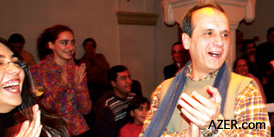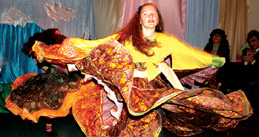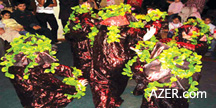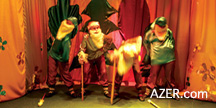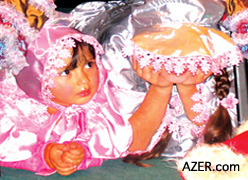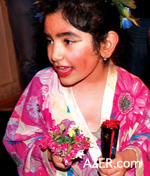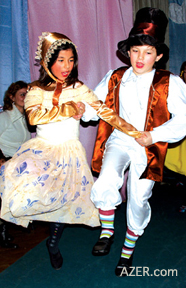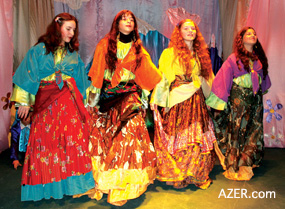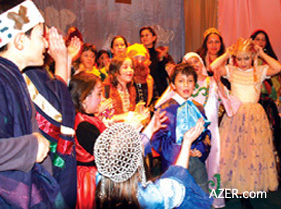|

Volume 15.1
Page
48 - 51
Didi Art Therapy
Studio
Creativity
and the Power of Healing in Children
by Zara Imayeva
|
"It's absolutely
wrong to talk with children about their experiences in war.
Children's minds are ready to replace negative emotions with
positive ones.
If you want to help children forget the trauma of war and other
stressful conditions,
then ignite their imagination with ideas of goodness, meaning
and beauty."
- Zara Imayeva, Director of Didi Art Therapy Studio in Baku |
  Left: Zara Imayeva, Didi Art Therapy Studio in Baku Left: Zara Imayeva, Didi Art Therapy Studio in Baku
These days, there's so much
talk of Post-Traumatic Stress Disorder (PTSD), a term used to
describe severe psychological disabilities, especially those
resulting from war. Children are particularly vulnerable to such
traumatic experiences.
Zara Imayeva makes no claims of having studied PTSD either clinically
or academically, but she's convinced that many psychiatrists
and psychologists are wrong in their approach about treating
children who have suffered through such experiences. So often,
these "experts" require children to focus on the trauma,
which, according to her, just causes them to relive the horror
and pain. Zara is convinced that healing is much more rapid when
the mind can focus on positive things - not negative ones. A
professional journalist, Zara, 42, arrived at these conclusions
from her own experiences and from being involved these last three
years in a group that she helped to create - the Didi Art Therapy
Studio in Baku, which involves 30 to 40 children.
For Zara, war is not an abstraction. She lived through the trauma
of war in Chechnya, twice having fled her mountain village near
Grozny. In the process, she lost her husband and was left, alone
- jobless and homeless - to care for their young son. Recovery
has been a painful process for Zara. Curiously her own well-being
has been intricately linked with her efforts to help children
erase the trauma of war through the therapeutic use of drama.
Zara tells her story here.
__________
People respond to trauma in very different ways. Some go on living
what appears to be quite normal lives. They don't stop creating
or planning. But in my situation, what I experienced in Chechnya
was so rehabilitating that I had no desire to go on. I didn't
want to live. I had lost everything - my home, my husband, friends.
I had no desire for anything. Absolutely nothing - no joy, no
travel, no love. At night, I would lay my head down on the pillow
simply because it was dark. In the morning, I would crawl out
of bed simply because that's what you do when it's light. But
it seemed so useless to live such a purposeless life or to think
about making any plans for the future. I'll never forget the
time, when about 30 or 40 of us had gathered in the basement
of what used to be the KGB building in hopes of finding refuge
from the bombing raids in Chechnya.
In between the attacks, the children would run out into the courtyard
to play. They had grown so accustomed to the sound of the engines
of the planes that they could discern between planes that were
a threat to us and those which weren't. The children would yell
out: "Don't be afraid of this one. It's already dropped
its load on other parts of the city. They won't bomb us."
That's how children in the midst of their play could respond
to that situation; but me, even to this day, whenever a plane
passes overhead - even a passenger plane - my knees start to
shake.
Didi was created in 2004 with the idea to provide psychological
rehabilitation for refugee children from Chechnya. We call it
"Didi" which means "baby" in the Chechen
language. But in the broader sense of the word, "Didi"
refers to a person who is still child-like: full of dreams, wishes
and imagination. We believe that these children should not be
denied the joy of childhood. It needs to be given back to them.
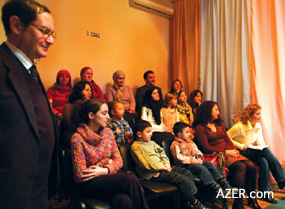 |
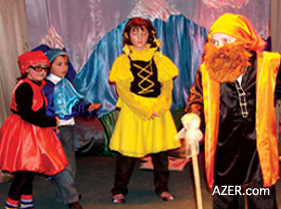 |
Above left:
The Children's theater,
located behind Azerbaijan Drama Theater, is designed to offer
a very intimate experience for both the performers and theater
goers. Small in size, it accommodates only about 50-60 people.
The stage is surrounded on three sides with tiered seats. Here,
the Swiss consul enjoys the program featuring Heidi. The Swiss
Consulate has helped to sponsor the efforts of Didi Art Therapy
Studio.
Above right:
Main characters in the play
about Heidi, who is shown wearing a yellow dress.
The main aim of the
Didi Art Therapy Group is to help children to be able to imagine
and dream and wish again. Only then will they become mentally
strong and healthy individuals and recognize their own human
dignity.
Above left:
Tarlan Gorchu, talented
artist in Baku whose family has played an integral role in the
establishment of Didi Art Therapy Studio.
Above right:
Gypsy dancers in Heidi.
Our group has grown to 30-40 children now. They come from various
nationalities: Chechens, Turks, Azerbaijanis and Americans. Some
of them have been fortunate to have normal childhoods, surrounded
by loving parents, homes, friends, warmth and peace in their
country.
Others have experienced the trauma of war first hand. Sometimes
their parents or close relatives were killed, and everything
that they used to associate with home has vanished. They now
live in a foreign country where everything is different and unfamiliar.
The main thing I've learned from these years of working so closely
with children in drama therapy is that one should never toy with
the feelings and emotions of children, no matter if you have
the best of intentions. Children who have experienced war and
who have undergone serious psychological stress should have their
childhood returned to them. Childhood means playing - playing
games that are joyful and merry, that makes one dream and imagine.
It's absolutely wrong to talk with children about their experiences
in war. Children's minds are ready to replace negative emotions
with positive ones. If you want to help children forget the trauma
of war and other stressful conditions, then ignite their imagination
with ideas of goodness, meaning and beauty.
Goals of Didi
Through creativity, children learn independence. They learn how
to control their bodies and how to use the intonation of their
voices. This brings enormous personal satisfaction. We want children
to learn tolerance. Through drama, children are introduced, both
consciously and subconsciously, to other cultures. We want them
to become multicultural and so together we learn Chechen dances,
Norwegian songs. We celebrate Azerbaijani holidays and perform
tales from many countries.
Above (left)
The Mushroom in Heidi, (middle) Dancing Baloba Trees in Little Prince.
Dance is
a major feature in Didi presentations, (right)
A scene of Leprachans in Heidi.
Repertoire
We choose our repertoire with care and deliberation. It's not
easy to select stories that will attract the interest of children
whose ages range from 3 to 14 years. But we do follow certain
criteria. We avoid stories that would exclude our children, such
as the typical story of a prince falling in love with a princess.
We also stay away from horror stories about mythical animals.
And we absolutely forbid any story that would require the use
of guns or any weapon on stage as a prop.
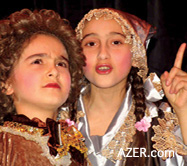  Currently,
we've been working on two major pieces: a story about a Swiss
girl called Heidi and "Le Petit Prince" (Little Prince)
by the French writer St. Exupery. Both works are more than an
hour in length and we try to involve as many children as possible
in each production. Currently,
we've been working on two major pieces: a story about a Swiss
girl called Heidi and "Le Petit Prince" (Little Prince)
by the French writer St. Exupery. Both works are more than an
hour in length and we try to involve as many children as possible
in each production.
For example, we scripted five sets of characters for Little Prince.
There were five princes, five pilots, five kings, five sheep,
five foxes and five roses. We feature a Chechen Little Prince,
as well as Azeri, Russian, British and French Little Princes,
too. Some scenes are even in English and French. I love "Little
Prince". This work has had a profound effect upon me at
different stages of my life. I hope the children will come to
love it, too. I first became acquainted with it as a teenager.
I was 14 or 15 at the time and I found it very boring.The next
time I read it, I found it very sad. Obviously, my perception
of the story has changed over the years to parallel my own life
experiences.
Above: The latest additions to the repertoire
of Didi Art Therapy Studio for Children in Baku include "Little
Prince" by French writer St. Exupery and "Heidi",
a little Swiss girl. To give many children a chance to perform
in Little Prince, five full sets of characters were created.
Five Little Princes, five kings, five pilots, five sheep and
five roses. Here, one of the Little Princes.
Above left: Little girls decked out as Rose and
Sheep in Little Prince.
Above right: A visit to
Japan in Heidi.
But for the children performing Little Prince, I just want them
to have good associations. In the future, they'll return to it
and understand that there can be many levels of meaning. I want
them to think of Exupery's works as bright, not dark.
Little Prince is really a story of love. And as such, it will
give strength in times of doubt and difficulties. I want them
to always remember profound lines such as: "It is only with
the heart that one can see rightly; what is essential is invisible
to the eye."
Above left:
The drama about Heidi included
a variety of dances from
many countries.
Above right:
Gypsy dancers in Heidi.
I take it as the greatest compliment when people come to our
performances and tell me afterwards that these children seem
so normal and happy, and when they wonder why I say these children
need psychological rehabilitation. Such words warm my heart because
I'm the one who knows how much these children have come through
and how much they have changed over time. Didi has made them
stronger and happier. And this is something no one can ever take
away from their hearts.
Above (left)
Gypsy dancers in Heidi,
(right)
End of a successful presentation
of Heidi. All the children who performed gather with Zara Imayeva,
Director of Didi (wearing black in the center background).
It's impossible to predict how one will react to severe trauma.
For me, to escape such an abyss, I needed to draw upon strength
outside of myself. My salvation came through Azerbaijani friends
who believed in me and helped me get involved with helping others,
who like me, had experienced too much pain. I wanted these young
children to grow up to be healthy personalities, vivacious and
strong. These friends helped me so much. They are to be credited
with my recovery and the birth of Didi group - people like Rahman
Badalov, Tarlan Gorchu, Ali Abbasov, and Vagif Ibrahimoghlu.
I could never abandon these children now even if I wanted to.
Not everybody is blessed with such dear relationships. It's like
being drenched in a shower of golden rain.
______
Back
Index AI 15.1
AI Home
| Magazine
Choice
| Topics
| AI Store | Contact us
Other Web sites
created by Azerbaijan International
AZgallery.org | AZERI.org | HAJIBEYOV.com
|





